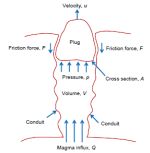EPJ B Highlight - Noise produces volcanic seismicity, akin to a drumbeat
- Details
- Published on 06 May 2015

A new study shows that relatively small external disturbances play a crucial role in chaotic phenomena like the recent Calbuco volcanic eruption in Chile, leading to drum-beat-like seismicity
Volcanoes are considered chaotic systems. They are difficult to model because the geophysical and chemical parameters in volcanic eruptions exhibit high levels of uncertainty. Now, Dmitri V. Alexandrov and colleagues from the Ural Federal University in Ekaterinburg, in the Russian Federation, have further extended an eruption model - previously developed by other scientists - to the friction force at work between the volcanic plug and volcanic conduit surface. The results, published in EPJ B, provide evidence that volcanic activity can be induced by external noises that would not otherwise have been predicted by the model.
Predicting when, where and how volcanic eruptions will happen is likely to remain empirical. That is, until it is possible to improve the modelling of their dynamics. The challenge of such models is that the volcanic eruption dynamics are very complex, involving simultaneous unrelated processes and offering a variety of possible scenarios.
The authors built on a previous study demonstrating the influence of noise in triggering eruptions. Namely, they assumed that, under complex friction forces, the volcano plug and conduit exhibit a previously identified mechanism, called stick-slip behaviour, which causes the volcanic plug to rise and fall in an attenuated manner. They then studied the influence of random disturbances on these dynamics. They also tested the resulting model with experimental data from the Mount St. Helen’s eruption, dating back to 2004 and 2005.
Alexandrov and colleagues show that the external noise is also linked to the appearance of large-amplitude oscillations in the volcanic plug and high seismicity. An increase in noise intensity leads to drumbeat-type plug movement, exhibiting irregular periodicity dependent on noise. Such beat-type behaviour is a building block for understanding the physical mechanisms of volcanic drumbeat seismicity.
D. V. Alexandrov, I. A. Bashkirtseva and L. B. Ryashko (2015), How a small noise generates large-amplitude oscillations in the volcanic plug and produces high seismicity, Eur. Phys. J. B 88: 106, DOI: 10.1140/epjb/e2015-60130-6





